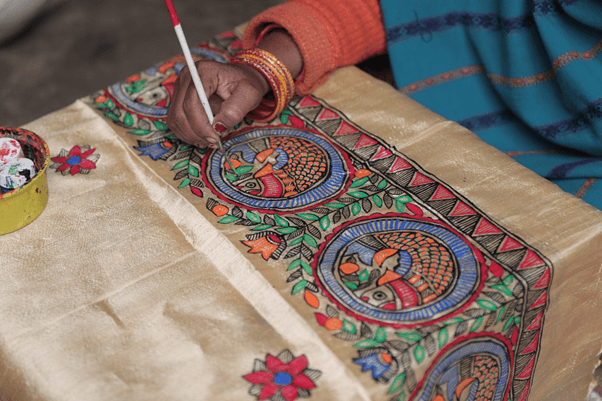Madhubani art, also known as Mithila painting, is a captivating style of folk painting that
originated in the Mithila region of India, encompassing parts of Bihar and Nepal. With its
vibrant colors, intricate patterns, and rich symbolism, Madhubani art has captivated art
enthusiasts and collectors worldwide.
A Glimpse into the Origins of Madhubani Art
The roots of Madhubani art can be traced back to ancient India, where it was traditionally
practiced by women of the Mithila region. These paintings were often created to adorn the
walls of mud huts during auspicious occasions like weddings, festivals, and childbirth
celebrations. The themes depicted in Madhubani art were deeply rooted in Hindu mythology,
showcasing stories of gods, goddesses, and epics.
The Unique Process of Madhubani Painting
Madhubani art is characterized by its distinctive style and process. Traditionally, natural dyes
and pigments were extracted from plants, vegetables, and minerals to create a vibrant palette
of colors. The paintings were typically done on clay walls, using twigs, matchsticks, and
fingers as paintbrushes. Today, artists may also use acrylic paints and canvases, but the essence of the traditional style remains preserved.
Madhubani artist creating a painting using traditional methods
The process of creating a Madhubani painting is meticulous and time-consuming. The first step involves preparing the surface, which is often smoothed with cow dung and coated with a mixture or rice flour and gum. Once the surface is dry, the artist outlines the main figures and motifs using a sharp-tipped instrument.
Next, the artist fills in the outlines with vibrant colors, often using a combination of dots, lines, and geometric patterns. The characteristic thick black borders add definition and contrast to the painting. The final step involves adding finishing touches, such as intricate details and embellishments.
Themes and Symbolism in Madhubani Art
Madhubani paintings are often imbued with deep symbolism and cultural significance. The themes depicted range from Hindu mythology and religious scenes to scenes of everyday life, nature, and social commentary. The use of specific colors and symbols carries deeper meanings, reflecting the artist’s beliefs and the cultural context of the region.

For instance, red symbolizes passion and energy, while blue represents spirituality and devotion. The depiction of gods and goddesses, such as Lord Krishna, Goddess Durga, and Lord Shiva, reflects the deep-rooted Hindu faith of the Mithila region. Scenes of everyday life, such as women engaged in household chores or men working in the fields, capture the essence of the region’s rural culture.
Madhubani art is recognized as a Geographical Indication (GI) product, ensuring its authenticity and origin. Madhubani art stands as a testament to the rich cultural heritage of India, showcasing the creativity, skill, and deep-rooted traditions of the Mithila region. With its vibrant colors, intricate patterns, and captivating themes, Madhubani art continues to mesmerize art lovers worldwide, serving as a bridge between India’s past and present.










